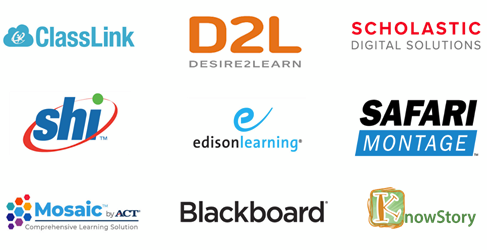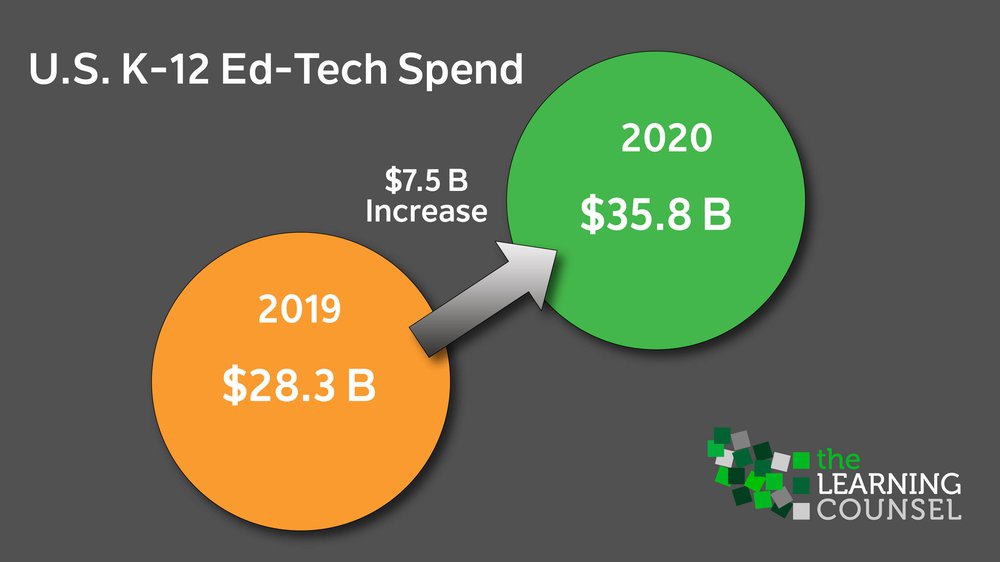The U.S. K-12 sector spent $35.8 Billion in 2020 on all things EdTech, including hardware, major software systems, digital curriculum resources and networks, a healthy increase of $7.8 Billion over 2019. This spike was largely due to the CARES Act and essential capital spending on EdTech to enable remote learning, especially in institutions that had to scramble to issue computing devices, software and urgent training for teachers and students. One computer manufacturer privately shared with the Learning Counsel that they sold over 18 million machines into U.S. schools in under three months. Many schools and districts in the survey cited difficulties getting orders filled due to the surge in demand.
Hardware sales, inclusive of most networking products, stood at $16.6 Billion, up by $4.5 Billion over 2019. Major software systems sales were $6.1 Billion, up by $900 over 2019.
Digital curriculum spend in 2020 was $13.1 Billion, an increase of $2.1 Billion over 2019. Paper resources spend dropped by $1 Billion to $6.9 Billion in 2020 (This spend does not include staffing). Digital curriculum spend includes digital textbooks, educational Apps, curriculum subscription sites, digital lesson plans, online video subscriptions, online news or library subscriptions, elearning curriculum also known as adaptive digital curriculum, courses or courseware, digital testing or assessment products and services, and any other digital learning content materials except major systems.
In 2020, The average district spent $4.4 Million on digital curriculum resources, with a $154.69 spend per student. Additional expenditure from school budgets is equivalent to $210,000 per school and $87.50 per student. Schools in the survey listed many of their digital learning resources, which commonly cost between $2 - $7 per student per year.
The Learning Counsel survey also reviewed the straight-to-consumer digital curriculum spending arena, which is estimated at $22.8 Billion, easily $9.7 Billion greater than all schools and district spending combined. LeiLani Cauthen, CEO of the Learning Counsel noted, “Parents went on a shopping spree for digital learning during quarantine, increasing spend on the consumer-side of learning resources by over $1 Billion in under six months. Prior to the pandemic, consumer growth had slowed, but is now roaring ahead again at 25 percent, year over year.”
Other metrics from the survey – out of 32,827 school and district participating respondents:
- 87 percent of schools and districts now issue individual students a personal computing device
- 58 percent expect purchase of devices to increase
- 25 percent expect purchase of devices to remain the same
- 75 percent expect purchase of digital curriculum to increase, up from 70% in 2019
- 13.46 percent cite achieving a 100 percent full coverage model of core curriculum (main subjects of math, language, science, social studies/history) with digital resources
- 33.5 percent are considering purchase of eSports related equipment and software
- 31 percent are considering social emotional software systems
- 33 percent are considering live tutoring systems
- 39 percent cite that 80-100 percent of teachers now use digital curriculum
- 23 percent cite that 60-80 percent of teachers now use digital curriculum
- 18 percent cite that 40-60 percent of teachers now use digital curriculum
- The largest portion of respondents, 39.3 percent, cited that they have a ratio of 50 percent free versus 50 percent paid digital learning resources
- The largest portion of respondents, 34.55 percent, cited that the use of digital curriculum and content comprises 50-75 percent of the school day
- From 2019 to 2020, the percentage of teachers spending 4-10 hours a week just searching around for digital lesson plan materials increased from 32 percent to 45 percent.
- While zero percent of respondents answered that teachers were spending above 10 hours a week just searching around for digital lesson plan materials in 2019, in 2020 it was 7 percent of teachers.
- From 2019 to 2020, the percentage of teachers spending 4-10 hours a week building their own digital learning content increased from 22 percent to 47 percent.
- The top type of professional development offered for teachers was tied at 86 percent of respondents citing these two types: 1) device training and 2) digital communications (Google, Microsoft, other communications & video conferencing apps.) Third at 84 percent was training on teaching practice and academic standards.
- An obvious weakness during the pandemic was the fact that most schools still rely on learning as 62 percent or more whole-group oriented rather than personalized workflow learning, core academics screen learning, small group learning, supplemental screen learning or project-based learning. Synchronous learning is still the predominant mode.
- 28 percent of schools and districts still have decentralized planning for all digital resources, meaning the teacher does all the selection and sequencing of content or app for lessons.
- 43 percent of schools and districts issue academic pacing guides in a non-automated way (some with minimal digital content references), and schools and teachers do decentralized lesson planning against those.
- 29 percent of schools and districts have centralized their plans with all digital resources and lessons by subject and by grade. These are mostly the all-online schools.
- Similar to every other year of this survey, in its 7th year, tight budgets were cited as the number one pressure point by 47 percent. The second highest pressure points were social and emotional needs of students and too much testing – tied at 41 percent.
- Teacher shortages were cited as the highest pressure point by 25 percent.
- Interestingly, 19 percent cited that “overall disequilibrium” was a major point of pressure.
- Both administrators and teachers cite “using data to enhance teaching” as the number one way they characterize digital transformation. Second for teachers was using interactive whiteboards and/or video conferencing technologies. Second for administrators was creating reports and analytics.
The Learning Counsel Research division completed the 2020 Digital Transition Survey in October. 32,827 educators engaged with the survey online, with 1,234 completions of this most comprehensive survey. In 2020 there was a 300 percent increase in responses from small and medium schools and districts. 65 schools, districts and service agencies were awarded one of the Learning Counsel’s prestigious EduJedi Levels of Gainer, Innovator, Achiever or Knight.
U.S. Demographics of the survey respondents were:
- 25% Urban
- 29% Suburban
- 39% Rural
- 7% Education Service Centers, BOCES, or State entities
The Learning Counsel acknowledges and thanks these sponsors for their underwriting the presentation of the Survey results briefing during the December 2nd Gathering virtual event:












